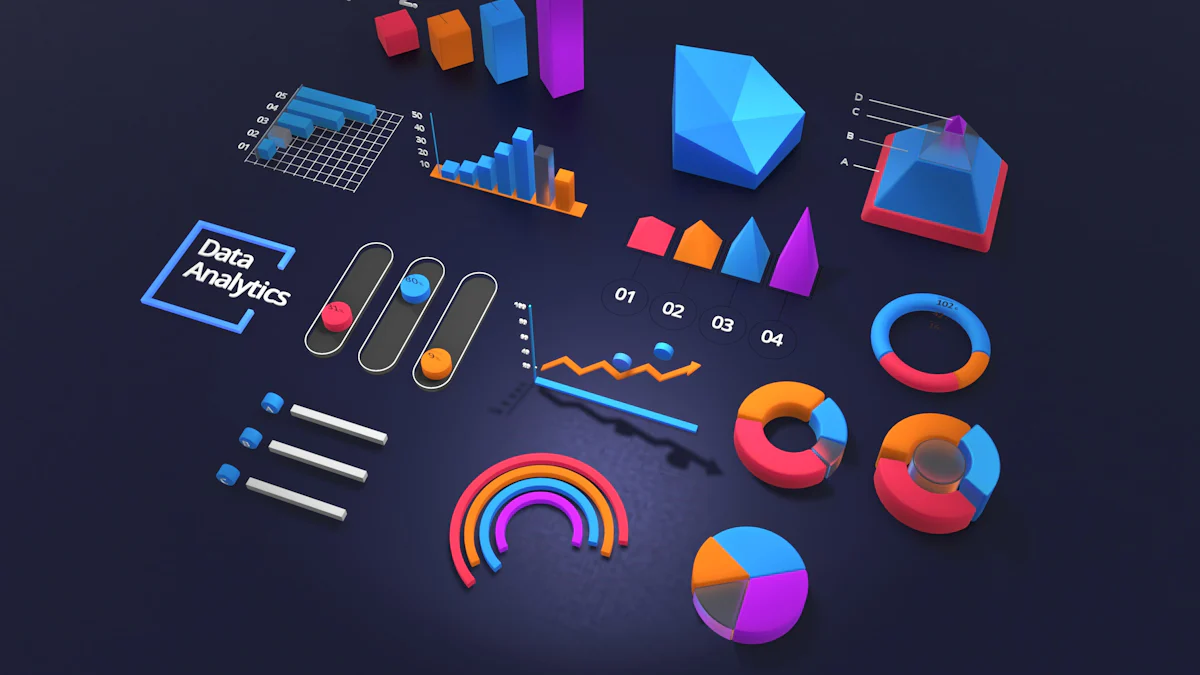A Deep Dive into Big Data Architecture Components

Big Data has become a cornerstone of the digital landscape. The volume of data generated, consumed, copied, and stored is projected to reach more than 180 zettabytes by 2025. This explosion of data underscores the complexity and necessity of a well-structured Big Data architecture. A robust architecture supports analytics processes, improves efficiency, and enables new services. The goal of this blog is to explore the key components of Big Data Architectures and understand their significance in modern enterprises.
Understanding Big Data Architectures
Definition and Importance
What is Big Data Architecture?
Big Data Architecture serves as the blueprint for managing and analyzing vast amounts of data. This architecture encompasses various components that work together to process, store, and analyze data efficiently. The design ensures that data flows seamlessly from sources to storage and then to processing and analysis stages. A well-structured Big Data Architecture enables organizations to handle data complexity and volume effectively.
Why is it crucial for modern enterprises?
Modern enterprises rely on Big Data Architectures to gain insights and make informed decisions. For instance, Netflix uses a recommendation algorithm that influences 80% of all content watched on the platform. This approach has led to better retention and $1 billion in savings. Similarly, Amazon Prime leverages Big Data analytics to recommend programming for individual users, enhancing user experience. Spotify offers personalized music suggestions, showcasing the importance of Big Data in delivering tailored services. These examples highlight how Big Data Architectures drive innovation and efficiency in various industries.
Core Principles
Scalability
Scalability stands as a fundamental principle of Big Data Architectures. This principle ensures that the system can handle increasing amounts of data without compromising performance. Enterprises must scale their architecture horizontally by adding more nodes or vertically by enhancing existing resources. Scalability allows organizations to manage growing data volumes and maintain efficient operations.
Flexibility
Flexibility in Big Data Architectures allows organizations to adapt to changing data requirements. This principle ensures that the architecture can accommodate different types of data, including structured, unstructured, and semi-structured data. Flexibility enables enterprises to integrate new data sources and technologies without overhauling the entire system. This adaptability proves essential for staying competitive in a rapidly evolving digital landscape.
Reliability
Reliability ensures that Big Data Architectures operate consistently and accurately. This principle focuses on minimizing downtime and ensuring data integrity. Reliable architectures incorporate redundancy and failover mechanisms to handle hardware failures and other disruptions. Reliability guarantees that data remains accessible and accurate, supporting critical business operations.
Key Components of Big Data Architectures

Data Sources
Data sources form the foundation of Big Data Architectures. These sources provide the initial input for processing and analysis.
Structured Data
Structured data refers to information that adheres to a predefined format. Examples include relational databases and spreadsheets. Structured data allows for easy querying and analysis due to its organized nature.
Unstructured Data
Unstructured data lacks a predefined format. Examples include text files, images, and videos. Handling unstructured data requires advanced tools and techniques. Big Data Architectures must accommodate this type of data for comprehensive analysis.
Semi-structured Data
Semi-structured data contains elements of both structured and unstructured data. Examples include JSON files and XML documents. This type of data requires flexible storage solutions. Big Data Architectures must support semi-structured data to provide a complete data picture.
Data Ingestion
Data ingestion involves collecting and transferring data from sources to storage systems. Effective data ingestion is crucial for Big Data Architectures.
Batch Processing
Batch processing handles large volumes of data at scheduled intervals. Tools like Hadoop and MapReduce support batch processing. This method is cost-efficient and suitable for non-time-sensitive tasks.
Real-time Processing
Real-time processing analyzes data as it is generated. Tools like Storm and Flink enable real-time data ingestion. This method provides immediate insights and supports time-sensitive applications.
Data Storage
Data storage is a critical component of Big Data Architectures. Efficient storage solutions ensure that large volumes of data can be stored and accessed quickly.
Data Lakes
Data lakes store raw data in its native format. This approach allows for flexibility in data analysis. Data lakes support various data types, including structured, unstructured, and semi-structured data.
Data Warehouses
Data warehouses store processed data for analysis. This approach uses structured formats to facilitate querying. Data warehouses are ideal for business intelligence and reporting.
NoSQL Databases
NoSQL databases offer flexible schema designs. This approach supports high scalability and performance. NoSQL databases are suitable for handling unstructured and semi-structured data.
Data Processing
Data processing transforms raw data into valuable insights. Big Data Architectures utilize both batch and stream processing frameworks to handle different data processing needs.
Batch Processing Frameworks
Batch processing frameworks process large volumes of data at scheduled intervals. Hadoop and MapReduce are popular tools for this method. These tools allow organizations to analyze massive datasets efficiently. Batch processing suits tasks that do not require immediate results. For example, generating monthly financial reports benefits from batch processing. This method ensures cost efficiency and accuracy in handling large datasets.
Stream Processing Frameworks
Stream processing frameworks analyze data as it arrives. Storm and Flink are leading tools in this category. These tools enable real-time data analysis, providing immediate insights. Stream processing is essential for applications requiring instant feedback. For instance, fraud detection systems rely on stream processing to identify suspicious activities promptly. This method supports time-sensitive operations, enhancing decision-making speed.
Data Analysis
Data analysis involves examining processed data to extract meaningful insights. Big Data Architectures support various types of analytics to meet diverse business needs.
Descriptive Analytics
Descriptive analytics summarizes historical data to understand past behaviors. This type of analysis answers questions like "What happened?" and "How did it happen?" Businesses use descriptive analytics to generate reports and dashboards. These insights help organizations track performance and identify trends.
Predictive Analytics
Predictive analytics forecasts future events based on historical data. This analysis answers questions like "What is likely to happen?" Tools like machine learning algorithms play a crucial role in predictive analytics. Businesses use these predictions to make informed decisions. For example, retail companies forecast sales trends to manage inventory effectively.
Prescriptive Analytics
Prescriptive analytics recommends actions based on data analysis. This type of analysis answers questions like "What should we do?" and "How can we achieve the best outcome?" Prescriptive analytics combines data, algorithms, and business rules to provide actionable insights. Organizations use these recommendations to optimize operations and improve outcomes.
Data Visualization
Data visualization presents data in graphical formats, making complex information easier to understand. Big Data Architectures incorporate various tools to enhance data interpretation.
Dashboards
Dashboards display key metrics and performance indicators in real-time. These visual tools offer a comprehensive view of business operations. Dashboards help organizations monitor progress and make quick decisions. For example, a marketing dashboard might show campaign performance, helping teams adjust strategies promptly.
Reporting Tools
Reporting tools generate detailed reports based on data analysis. These tools provide structured summaries of data, supporting in-depth analysis. Reports help organizations communicate findings and make data-driven decisions. For instance, financial reports offer insights into revenue trends, guiding budgeting and investment choices.
Applications of Big Data Architectures

Industry Use Cases
Healthcare
Big Data Architectures have revolutionized healthcare. Hospitals use data analytics to predict patient admissions. This helps in resource allocation. Predictive models identify high-risk patients. Early interventions improve patient outcomes. Genomic data analysis aids in personalized medicine. Researchers use big data to track disease outbreaks. This enables timely public health responses.
Finance
The finance industry benefits greatly from Big Data Architectures. Banks use data analytics for fraud detection. Real-time data processing identifies suspicious transactions. Investment firms analyze market trends. This helps in making informed decisions. Customer data analysis improves personalized banking services. Credit scoring models use big data for accurate risk assessment.
Retail
Retailers leverage Big Data Architectures to enhance customer experience. Data analytics helps in understanding customer behavior. This leads to personalized marketing strategies. Inventory management becomes efficient with real-time data. Retailers predict demand and optimize stock levels. Sales data analysis identifies trends and preferences. This supports targeted promotions and product recommendations.
Benefits
Improved Decision Making
Big Data Architectures enable improved decision making. Data-driven insights guide strategic planning. Organizations analyze historical data to identify patterns. Predictive analytics forecast future trends. This helps in proactive decision making. Real-time data provides immediate insights. This supports quick and informed actions.
Enhanced Customer Experience
Enhanced customer experience is a key benefit of Big Data Architectures. Data analytics helps in understanding customer needs. Personalized services improve customer satisfaction. Real-time data enables prompt responses to customer queries. Predictive models anticipate customer preferences. This leads to tailored recommendations and offers.
Operational Efficiency
Big Data Architectures boost operational efficiency. Data analytics streamline business processes. Organizations identify inefficiencies and optimize operations. Real-time data monitoring ensures timely interventions. Predictive maintenance reduces downtime. This leads to cost savings and improved productivity.
Challenges and Future Considerations
Challenges
Data Security
Data security remains a significant challenge in Big Data Architectures. Protecting sensitive information from breaches and unauthorized access is crucial. Organizations must implement robust encryption methods and access controls. Regular security audits help identify vulnerabilities. Compliance with data protection regulations ensures legal adherence.
Data Quality
Maintaining data quality poses another challenge. Inconsistent or inaccurate data can lead to flawed analysis. Organizations must establish data governance frameworks. Regular data cleaning and validation processes improve data quality. High-quality data supports reliable insights and decision-making.
Integration Issues
Integration issues arise when combining data from various sources. Different formats and structures complicate the process. Organizations need effective data integration tools. Standardizing data formats facilitates smoother integration. Seamless integration ensures comprehensive data analysis.
Future Trends
AI and Machine Learning Integration
AI and machine learning integration represent a significant trend in Big Data Architectures. These technologies enhance data analysis capabilities. Machine learning algorithms identify patterns and trends. AI-driven insights support predictive and prescriptive analytics. Organizations leverage these technologies for advanced decision-making.
Edge Computing
Edge computing is gaining traction in Big Data Architectures. This approach processes data closer to the source. Reducing latency improves real-time data analysis. Edge computing supports applications requiring immediate insights. Enhanced processing power at the edge boosts overall system efficiency.
Data Governance
Data governance will play a crucial role in future Big Data Architectures. Effective governance ensures data integrity and compliance. Organizations must establish clear data policies and procedures. Regular monitoring and auditing maintain data standards. Strong governance frameworks support ethical and responsible data use.
Understanding Big Data architecture components is crucial for modern enterprises. A well-structured architecture enhances decision-making, customer experience, and operational efficiency. Organizations must stay updated with future trends like AI integration and edge computing. Effective data governance ensures data integrity and compliance. Collaboration across sectors drives innovation and growth in the data space. The rise of real-time data reporting will become mainstream. Businesses that leverage these advancements will maintain a competitive edge.
See Also
Deciphering Cloud Data Structure
The Significance of Modern Big Data Solutions
